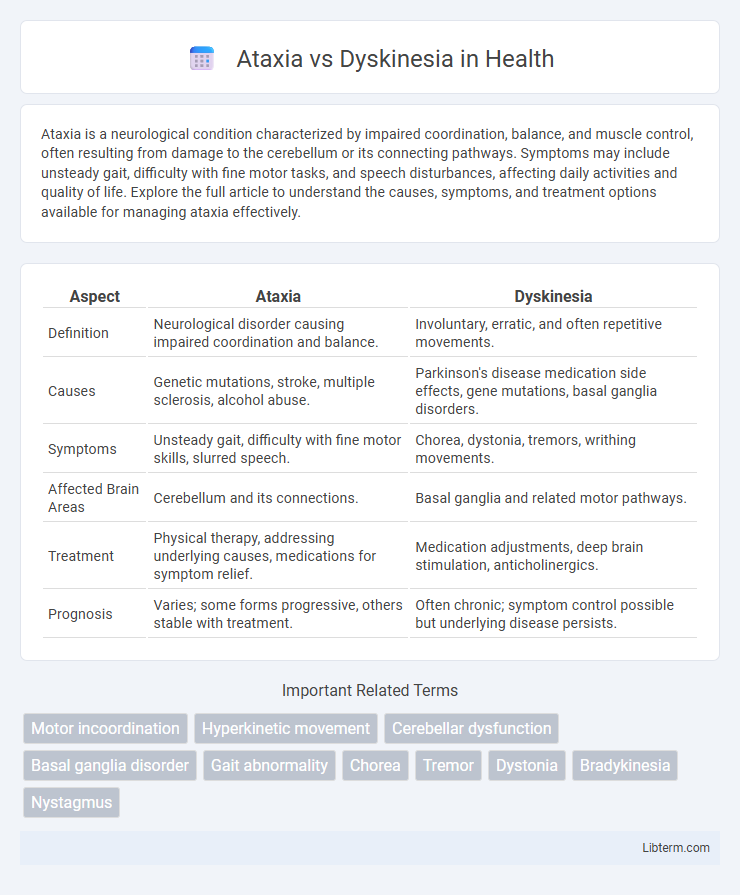Ataxia is a neurological condition characterized by impaired coordination, balance, and muscle control, often resulting from damage to the cerebellum or its connecting pathways. Symptoms may include unsteady gait, difficulty with fine motor tasks, and speech disturbances, affecting daily activities and quality of life. Explore the full article to understand the causes, symptoms, and treatment options available for managing ataxia effectively.
Table of Comparison
| Aspect | Ataxia | Dyskinesia |
|---|---|---|
| Definition | Neurological disorder causing impaired coordination and balance. | Involuntary, erratic, and often repetitive movements. |
| Causes | Genetic mutations, stroke, multiple sclerosis, alcohol abuse. | Parkinson's disease medication side effects, gene mutations, basal ganglia disorders. |
| Symptoms | Unsteady gait, difficulty with fine motor skills, slurred speech. | Chorea, dystonia, tremors, writhing movements. |
| Affected Brain Areas | Cerebellum and its connections. | Basal ganglia and related motor pathways. |
| Treatment | Physical therapy, addressing underlying causes, medications for symptom relief. | Medication adjustments, deep brain stimulation, anticholinergics. |
| Prognosis | Varies; some forms progressive, others stable with treatment. | Often chronic; symptom control possible but underlying disease persists. |
Understanding Ataxia: Definition and Causes
Ataxia is a neurological disorder characterized by impaired coordination, balance, and speech, resulting from damage to the cerebellum or its pathways. Causes of ataxia include genetic mutations, stroke, multiple sclerosis, traumatic brain injury, and exposure to toxins such as alcohol or heavy metals. Understanding ataxia's etiology is crucial for accurate diagnosis and targeted treatment, differentiating it from dyskinesia, which involves involuntary, erratic movements caused primarily by basal ganglia dysfunction.
What is Dyskinesia? An Overview
Dyskinesia refers to involuntary, erratic, and often repetitive movements typically caused by long-term use of medications like levodopa in Parkinson's disease patients. These abnormal movements can include chorea, dystonia, and tics, significantly impacting motor control and quality of life. Dyskinesia differs from ataxia, which primarily involves lack of coordinated muscle movements rather than involuntary muscle contractions.
Key Differences: Ataxia vs Dyskinesia
Ataxia is characterized by impaired coordination and balance due to cerebellar dysfunction, whereas dyskinesia involves involuntary, erratic movements often linked to basal ganglia disorders. Ataxia typically manifests as unsteady gait and clumsiness, while dyskinesia includes symptoms like chorea, dystonia, or tremors. The underlying causes differ, with ataxia often resulting from neurodegenerative diseases or stroke and dyskinesia commonly emerging as side effects of long-term Parkinson's disease treatment.
Common Symptoms of Ataxia
Ataxia commonly presents with symptoms such as impaired coordination, unsteady gait, and difficulty with fine motor tasks like writing or buttoning clothes. Patients often experience dysarthria, or slurred speech, and nystagmus, which are involuntary eye movements. These symptoms result from dysfunction in the cerebellum or its neural pathways, distinguishing ataxia from dyskinesia, which primarily involves involuntary, erratic movements.
Typical Manifestations of Dyskinesia
Dyskinesia is characterized by involuntary, erratic, and often repetitive movements such as chorea, dystonia, and tics, typically affecting the face, limbs, and trunk. These movements can range from slow, writhing gestures to rapid, jerky motions and are frequently seen in conditions like Parkinson's disease and as side effects of long-term dopaminergic therapy. Unlike ataxia, which primarily involves impaired coordination and balance, dyskinesia predominantly manifests as uncontrolled hyperkinetic motor activity.
Underlying Neurological Mechanisms Compared
Ataxia arises from dysfunction in the cerebellum or its pathways, leading to impaired coordination, balance, and motor control due to disrupted proprioceptive feedback and cerebellar processing. Dyskinesia is primarily caused by abnormalities in the basal ganglia, particularly involving dopaminergic signaling disruptions in the striatum, resulting in involuntary, erratic, and uncontrolled movements. Differences in the affected neural circuits highlight ataxia's association with cerebellar circuitry impairment, while dyskinesia reflects basal ganglia motor circuit disturbances.
Diagnostic Methods for Ataxia and Dyskinesia
Diagnostic methods for ataxia include neurological examinations, MRI scans to detect cerebellar atrophy or lesions, and genetic testing for hereditary forms. Dyskinesia diagnosis often involves clinical observation of involuntary movements, response to dopaminergic medications, and electromyography (EMG) to assess muscle activity. Both conditions may require video recording to analyze movement patterns and differentiate from other movement disorders.
Treatment Approaches: Ataxia vs Dyskinesia
Treatment approaches for ataxia primarily involve physical therapy, occupational therapy, and medications aimed at managing symptoms, as no definitive cure exists for most types. In contrast, dyskinesia treatments often focus on adjusting dopaminergic medications, particularly in Parkinson's disease, alongside options like deep brain stimulation and anticholinergic drugs to reduce involuntary movements. Both conditions require tailored therapeutic strategies that address underlying pathology and improve patients' motor function and quality of life.
Prognosis and Long-term Management
Ataxia often presents with progressive symptoms affecting coordination, and its prognosis varies widely depending on the underlying cause, with some forms being manageable through physical therapy and supportive care to maintain function. Dyskinesia, frequently a side effect of long-term dopaminergic treatment in Parkinson's disease, can be managed by adjusting medication regimens, using deep brain stimulation, or adding specific pharmacologic agents to reduce involuntary movements. Long-term management of both conditions requires multidisciplinary approaches, including neurologic assessment, rehabilitation therapies, and personalized treatment strategies to optimize quality of life.
Living with Movement Disorders: Patient Perspectives
Living with movement disorders such as ataxia and dyskinesia presents unique challenges in daily life, including impaired coordination and involuntary movements. Patients often experience difficulties in maintaining independence and managing symptoms, which significantly impact their quality of life and emotional well-being. Support from specialized therapies, adaptive devices, and patient communities plays a crucial role in coping strategies and enhancing functional abilities.
Ataxia Infographic

 libterm.com
libterm.com